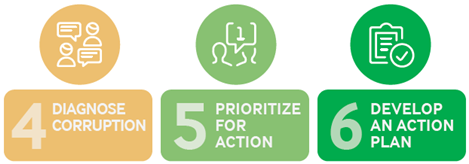
Diagnosing Corruption in the Extractive Sector: A Tool for Research and Action
NRGI’s corruption diagnostic tool aims to support anticorruption actors as they tackle the complex and sensitive challenge of extractive sector corruption. Drawing on extensive sector-specific analysis, the tool enables its users to:
- Gather evidence and convene consultations to identify the forms of corruption most likely to negatively impact their country’s extractive industries;
- Diagnose the causes of these forms of corruption;
- Build an evidence-based anticorruption action plan, focused on preventing future corruption.
Read the authors’ blog about the launch of the tool.
Each assessment involves three key actors: the organization that commissions the assessment (the “user”), an independent expert leading the research (the “independent expert”) and a wider set of stakeholders from government, industry and civil society, who are consulted during the process. These actors work together to implement the following six steps.
- Choose a sector and set goals: The user identifies the sector or commodity that will be assessed and formulates a set of broad goals that describe the motivations for conducting the diagnosis.
- Review existing data: Through desk research, the independent expert reviews a core set of existing data and analysis on corruption and governance in the country’s extractive sector, flagging leading challenges and opportunities.
- Select the areas of focus: Based on the Step 2 analysis and multi-stakeholder input, the user identifies the most relevant area of focus for in-depth analysis and eventual action planning.
- Diagnose corruption: The independent expert then conducts in-depth research and analysis on the chosen area of focus to identify common forms of corruption, why they occur and how different actors might address them. Research methods include interviews, focus groups, desk research and surveys.
- Prioritize forms of corruption for action: Drawing on the Step 4 findings and multi-stakeholder input, the user prioritizes which forms of corruption to address in the action planning.
- Develop an action plan: With support from the independent expert, the user engages a relevant set of stakeholders to develop an action plan targeting the forms of corruption prioritized in Step 5. Dissemination, implementation and monitoring then ensue.
Guidance for conducting these steps is found in the main document (“Diagnosing Corruption in the Extractive Sector: A Tool for Research and Action”) as well as the annexes, including detailed research guides on each of the possible areas of focus. All can be downloaded to the right.
The research guides describe prevalent forms of corruption in specific areas of extractive sector governance (licensing; operations; revenue collection; revenue management; and SOEs), as well as common red flags, leading anticorruption good practices and other information. The guides may hold value for readers interested in understanding corruption trends in these areas, in addition to those conducting assessments.
Authors

Alexandra Gillies
Contributor


Matthieu Salomon
Acting Governance Programs Director | Lead, Anticorruption


